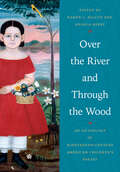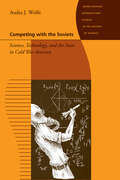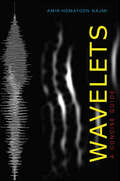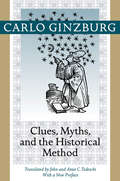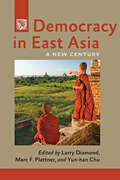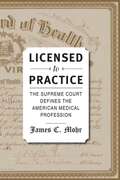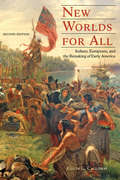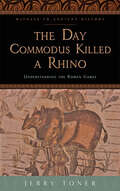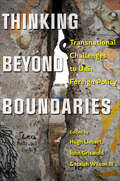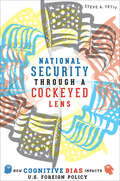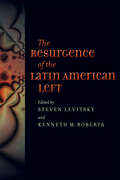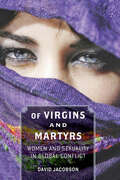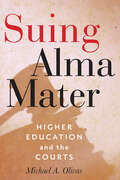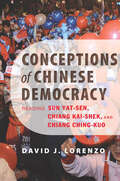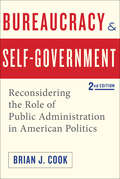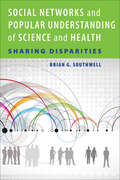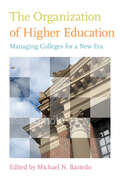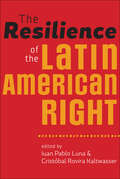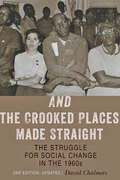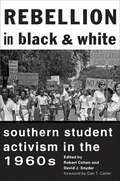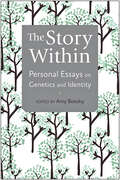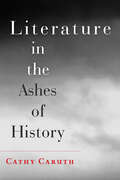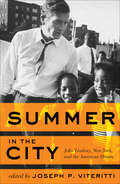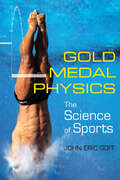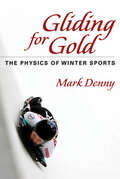- Table View
- List View
Over the River and Through the Wood: An Anthology of Nineteenth-Century American Children's Poetry
by Karen L. Kilcup Angela SorbyOver the River and Through the Wood is the first and only collection of its kind, offering readers an unequaled view of the quality and diversity of nineteenth-century American children's poetry. Most American poets wrote for children—from famous names such as Ralph Waldo Emerson to less familiar figures like Christina Moody, an African American author who published her first book at sixteen. In its excellence, relevance, and abundance, much of this work rivals or surpasses poetry written for adults, yet it has languished—inaccessible and unread—in old periodicals, gift books, and primers. This groundbreaking anthology remedies that loss, presenting material that is both critical to the tradition of American poetry and also a delight to read.Complemented by period illustrations, this definitive collection includes work by poets from all geographical regions, as well as rarely seen poems by immigrant and ethnic writers and by children themselves. Karen L. Kilcup and Angela Sorby have combed the archives to present an extensive selection of rediscoveries along with traditional favorites. By turns playful, contemplative, humorous, and subversive, these poems appeal to modern sensibilities while giving scholars a revised picture of the nineteenth-century literary landscape.
Competing with the Soviets: Science, Technology, and the State in Cold War America (Johns Hopkins Introductory Studies in the History of Science)
by Audra J. WolfeFor most of the second half of the twentieth century, the United States and its allies competed with a hostile Soviet Union in almost every way imaginable except open military engagement. The Cold War placed two opposite conceptions of the good society before the uncommitted world and history itself, and science figured prominently in the picture. Competing with the Soviets offers a short, accessible introduction to the special role that science and technology played in maintaining state power during the Cold War, from the atomic bomb to the Human Genome Project.The high-tech machinery of nuclear physics and the space race are at the center of this story, but Audra J. Wolfe also examines the surrogate battlefield of scientific achievement in such diverse fields as urban planning, biology, and economics; explains how defense-driven federal investments created vast laboratories and research programs; and shows how unfamiliar worries about national security and corrosive questions of loyalty crept into the supposedly objective scholarly enterprise.Based on the assumption that scientists are participants in the culture in which they live, Competing with the Soviets looks beyond the debate about whether military influence distorted science in the Cold War. Scientists’ choices and opportunities have always been shaped by the ideological assumptions, political mandates, and social mores of their times. The idea that American science ever operated in a free zone outside of politics is, Wolfe argues, itself a legacy of the ideological Cold War that held up American science, and scientists, as beacons of freedom in contrast to their peers in the Soviet Union. Arranged chronologically and thematically, the book highlights how ideas about the appropriate relationships among science, scientists, and the state changed over time.
Wavelets: A Concise Guide
by Amir-Homayoon NajmiIntroduced nearly three decades ago as a variable resolution alternative to the Fourier transform, a wavelet is a short oscillatory waveform for analysis of transients. The discrete wavelet transform has remarkable multi-resolution and energy-compaction properties. Amir-Homayoon Najmi’s introduction to wavelet theory explains this mathematical concept clearly and succinctly. Wavelets are used in processing digital signals and imagery from myriad sources. They form the backbone of the JPEG2000 compression standard, and the Federal Bureau of Investigation uses biorthogonal wavelets to compress and store its vast database of fingerprints. Najmi provides the mathematics that demonstrate how wavelets work, describes how to construct them, and discusses their importance as a tool to investigate and process signals and imagery. He reviews key concepts such as frames, localizing transforms, orthogonal and biorthogonal bases, and multi-resolution. His examples include the Haar, the Shannon, and the Daubechies families of orthogonal and biorthogonal wavelets.Our capacity and need for collecting and transmitting digital data is increasing at an astonishing rate. So too is the importance of wavelets to anyone working with and analyzing digital data. Najmi’s primer will be an indispensable resource for those in computer science, the physical sciences, applied mathematics, and engineering who wish to obtain an in-depth understanding and working knowledge of this fascinating and evolving field.
Clues, Myths, and the Historical Method
by Carlo GinzburgMore than twenty years after Clues, Myths, and the Historical Method was first published in English, this extraordinary collection remains a classic. The book brings together essays about Renaissance witchcraft, National Socialism, sixteenth-century Italian painting, Freud’s wolf-man, and other topics. In the influential centerpiece of the volume Carlo Ginzburg places historical knowledge in a long tradition of cognitive practices and shows how a research strategy based on reading clues and traces embedded in the historical record reveals otherwise hidden information. Acknowledging his debt to art history, psychoanalysis, comparative religion, and anthropology, Ginzburg challenges us to retrieve cultural and social dimensions beyond disciplinary boundaries.In his new preface, Ginzburg reflects on how easily we miss the context in which we read, write, and live. Only hindsight allows some understanding. He examines his own path in research during the 1970s and its relationship to the times, especially the political scenes of Italy and Germany. Was he influenced by the environment, he asks himself, and if so, how? Ginzburg uses his own experience to examine the elusive and constantly evolving nature of history and historical research.
Democracy in East Asia: A New Century (A Journal of Democracy Book)
by Larry Diamond Marc F. Plattner Yun-Han ChuIn their introduction to the 1998 edition of Democracy in East Asia, Larry Diamond and Marc F. Plattner predicted that East Asia, with its remarkable diversity of political regimes, economies, and religions, would likely be the most critical arena in the global struggle for democracy, a prediction that has proven prescient. Although the recent political upheavals in the Middle East have understandably grabbed the world’s attention, there is reason to doubt whether the overthrow of some authoritarian regimes there will lead to the establishment of stable democracies any time soon. On the other hand, East Asia, the world’s most populous and economically dynamic region, already boasts several consolidated democracies and provides a fascinating laboratory for studies of both authoritarian resilience and the prospects for democratization. This updated volume, which features contributions by distinguished scholars in East Asian studies, will be welcomed by instructors and students in the field, particularly as U.S. foreign policy is in the process of undertaking a "pivot" toward Asia.Democracy in East Asia offers a comprehensive treatment of the political landscape in both Northeast and Southeast Asia, including discussions of China, Japan, South Korea, Taiwan, Indonesia, the Philippines, Malaysia, Singapore, Thailand, Cambodia, Laos, Vietnam, and Burma (Myanmar). Contributors: Larry Diamond, Marc F. Plattner, Francis Fukuyama, Minxin Pei, Yun-han Chu, Hyug Baeg Im, Thitinan Pongsudhirak, Dan Slater, Martin Gainsborough, Don Emmerson, Edward Aspinall, Mark Thompson, Benjamin Reilly, Joseph Wong, Chong-Min Park, Yu-tzung Chang
Licensed to Practice: The Supreme Court Defines the American Medical Profession
by James C. MohrLicensed to Practice begins with an 1891 shooting in Wheeling, West Virginia, that left one doctor dead and another on trial for his life. Formerly close friends, the doctors had fallen out over the issue of medical licensing. Historian James C. Mohr calls the murder "a sorry personal consequence of the far larger and historically significant battle among West Virginia’s physicians over the future of their profession."Through most of the nineteenth century, anyone could call themselves a doctor and could practice medicine on whatever basis they wished. But an 1889 U.S. Supreme Court case, Dent v. West Virginia, effectively transformed medical practice from an unregulated occupation to a legally recognized profession. The political and legal battles that led up to the decision were unusually bitter—especially among physicians themselves—and the outcome was far from a foregone conclusion.So-called Regular physicians wanted to impose their own standards on the wide-open medical marketplace in which they and such non-Regulars as Thomsonians, Botanics, Hydropaths, Homeopaths, and Eclectics competed. The Regulars achieved their goal by persuading the state legislature to make it a crime for anyone to practice without a license from the Board of Health, which they controlled. When the high court approved that arrangement—despite constitutional challenges—the licensing precedents established in West Virginia became the bedrock on which the modern American medical structure was built. And those precedents would have profound implications. Thus does Dent, a little-known Supreme Court case, influence how Americans receive health care more than a hundred years after the fact.
New Worlds for All: Indians, Europeans, and the Remaking of Early America (The American Moment)
by Colin G. CallowayAlthough many Americans consider the establishment of the colonies as the birth of this country, in fact early America existed long before the arrival of the Europeans. From coast to coast, Native Americans had created enduring cultures, and the subsequent European invasion remade much of the land and society. In New Worlds for All, Colin G. Calloway explores the unique and vibrant new cultures that Indians and Europeans forged together in early America. The journey toward this hybrid society kept Europeans' and Indians' lives tightly entwined: living, working, worshiping, traveling, and trading together—as well as fearing, avoiding, despising, and killing one another. In some areas, settlers lived in Indian towns, eating Indian food. In the Mohawk Valley of New York, Europeans tattooed their faces; Indians drank tea. A unique American identity emerged.The second edition of New Worlds for All incorporates fifteen years of additional scholarship on Indian-European relations, such as the role of gender, Indian slavery, relationships with African Americans, and new understandings of frontier society.
The Day Commodus Killed a Rhino: Understanding the Roman Games (Witness to Ancient History)
by Jerry TonerThe Roman emperor Commodus wanted to kill a rhinoceros with a bow and arrow, and he wanted to do it in the Colosseum. Commodus’s passion for hunting animals was so fervent that he dreamt of shooting a tiger, an elephant, and a hippopotamus; his prowess was such that people claimed he never missed when hurling his javelin or firing arrows from his bow. For fourteen days near the end of AD 192, the emperor mounted one of the most lavish and spectacular gladiatorial games Rome had ever seen. Commodus himself was the star attraction, and people rushed from all over Italy to witness the spectacle. But this slaughter was simply the warm-up act to the main event: the emperor was also planning to fight as a gladiator.Why did Roman rulers spend vast resources on such over-the-top displays—and why did some emperors appear in them as combatants? Why did the Roman rabble enjoy watching the slaughter of animals and the sight of men fighting to the death? And how best can we in the modern world understand what was truly at stake in the circus and the arena? In The Day Commodus Killed a Rhino, Jerry Toner set out to answer these questions by vividly describing what it would have been like to attend Commodus’ fantastic shows and watch one of his many appearances as both hunter and fighter. Highlighting the massive logistical effort needed to supply the games with animals, performers, and criminals for execution, the book reveals how blood and gore were actually incidental to what really mattered. Gladiatorial games played a key role in establishing a forum for political debate between the rulers and the ruled. Roman crowds were not passive: they were made up of sophisticated consumers with their own political aims, which they used the games to secure. In addition, the games also served as a pure expression of what it meant to be a true Roman. Drawing on notions of personal honor, manly vigor, and sophisticated craftsmanship, the games were a story that the Romans loved to tell themselves about themselves.
Thinking beyond Boundaries: Transnational Challenges to U.S. Foreign Policy
by Hugh Liebert John Griswold Isaiah WilsonWritten under the direction of West Point social sciences faculty for its Student Conference on U.S. Affairs (SCUSA), Thinking beyond Boundaries introduces undergraduates to aspects of transnational conflict that extend beyond traditional political and intellectual boundaries, providing context to a variety of contemporary issues including immigration, terrorism, and environmental security. This volume challenges students to behave not as passive observers but as decision makers who engage in policy-level debate and formulate specific policy recommendations. The contributors ask students to consider how the United States promotes or even determines an effective and appropriate policy response to boundary-spanning problems. Since future political and military leaders, as well as policymakers, will face the challenge of collective action within the confines of an uncoordinated international system, the book urges students to consider the role of domestic and foreign factors in their decision-making processes. The book’s three-part organization considers the blurred line between domestic and foreign policy, the cross-border implications of foreign policy, and the challenges and opportunities that extend beyond the boundaries separating the world’s regions. Each chapter includes a list of recommended readings and resources. Touching on civil-military relations and the global challenges involved with hacking, foreign aid, weapons proliferation, international trade, and climate change, Thinking beyond Boundaries draws thoughtful conclusions about the proper role of the United States around the world.
National Security through a Cockeyed Lens: How Cognitive Bias Impacts U.S. Foreign Policy
by Steve A. Yetiv"How do mental errors or cognitive biases undermine good decision making?" This is the question Steve A. Yetiv takes up in his latest foreign policy study, National Security through a Cockeyed Lens.Yetiv draws on four decades of psychological, historical, and political science research on cognitive biases to illuminate some of the key pitfalls in our leaders’ decision-making processes and some of the mental errors we make in perceiving ourselves and the world.Tracing five U.S. national security episodes—the 1979 Soviet invasion and occupation of Afghanistan; the Iran-Contra affair during the Reagan administration; the rise of al-Qaeda, leading to the 9/11 attacks; the 2003 U.S. invasion of Iraq; and the development of U.S. energy policy—Yetiv reveals how a dozen cognitive biases have been more influential in impacting U.S. national security than commonly believed or understood. Identifying a primary bias in each episode—disconnect of perception versus reality, tunnel vision ("focus feature"), distorted perception ("cockeyed lens"), overconfidence, and short-term thinking—Yetiv explains how each bias drove the decision-making process and what the outcomes were for the various actors. His concluding chapter examines a range of debiasing techniques, exploring how they can improve decision making.
The Resurgence of the Latin American Left
by Steven Levitsky Kenneth M. RobertsLatin America experienced an unprecedented wave of left-leaning governments between 1998 and 2010. This volume examines the causes of this leftward turn and the consequences it carries for the region in the twenty-first century.The Resurgence of the Latin American Left asks three central questions: Why have left-wing parties and candidates flourished in Latin America? How have these leftist parties governed, particularly in terms of social and economic policy? What effects has the rise of the Left had on democracy and development in the region? The book addresses these questions through two sections. The first looks at several major themes regarding the contemporary Latin American Left, including whether Latin American public opinion actually shifted leftward in the 2000s, why the Left won in some countries but not in others, and how the left turn has affected market economies, social welfare, popular participation in politics, and citizenship rights. The second section examines social and economic policy and regime trajectories in eight cases: those of leftist governments in Argentina, Bolivia, Brazil, Chile, Ecuador, Uruguay, and Venezuela, as well as that of a historically populist party that governed on the right in Peru. Featuring a new typology of Left parties in Latin America, an original framework for identifying and categorizing variation among these governments, and contributions from prominent and influential scholars of Latin American politics, this historical-institutional approach to understanding the region’s left turn—and variation within it—is the most comprehensive explanation to date on the topic.
Of Virgins and Martyrs: Women and Sexuality in Global Conflict (Themes in Global Social Change)
by David JacobsonWomen's bodies have become a battleground. Around the world, people argue about veiling, schooling for Afghan girls, and "SlutWalk" protests, all of which involve issues of women's sexuality and freedom. Globalization, with its emphasis on human rights and individuality, heats up these arguments. In Of Virgins and Martyrs, David Jacobson takes the reader on a fascinating tour of how self-identity developed throughout history and what individualism means for Muslim societies struggling to maintain a sense of honor in a globalized twenty-first century.Some patriarchal societies have come to see women’s control of their own sexuality as a threat to a way of life that goes back thousands of years. Many trace their lineage to tribal cultures that were organized around the idea that women’s virginity represents the honor of male relatives and the good of the community at large. Anyone or anything that influences women to the contrary is considered a corrupting and potentially calamitous force. Jacobson analyzes the connection between tribal patriarchy and Muslim radicalism through an innovative tool—the tribal patriarchy index. This index helps to illuminate why women's sexuality, dress, and image so compel militant Muslim outrage and sometimes violent action, revealing a deeper human story of how women's status defines competing moral visions of society and why this present clash is erupting with such ferocity.
Suing Alma Mater: Higher Education and the Courts
by Michael A. OlivasAlthough much has been written about U.S. Supreme Court decisions involving higher education, little has been said about the foundational case law and litigation patterns emerging from the lower courts. As universities become increasingly legislated, regulated, and litigious, campuses have become testing grounds for a host of constitutional challenges. From faculty and student free speech to race- or religion-based admissions policies, Suing Alma Mater describes the key issues at play in higher education law.Eminent legal scholar Michael A. Olivas considers higher education litigation in the latter half of the twentieth century and the rise of "purposive organizations," like the American Civil Liberties Union and the Alliance Defense Fund (now known as the Alliance Defending Freedom), that exist to advance litigation. He reviews more than 120 college cases brought before the Supreme Court in the past fifty years and then discusses six key cases in depth. Suing Alma Mater provides a clear-eyed perspective on the legal issues facing higher education today.
Conceptions of Chinese Democracy: Reading Sun Yat-sen, Chiang Kai-shek, and Chiang Ching-kuo
by David J. LorenzoConceptions of Chinese Democracy provides a coherent and critical introduction to the democratic thought of three fathers of modern Taiwan—Sun Yat-sen, Chiang Kai-shek, and Chiang Ching-kuo—in a way that is accessible and grounded in broader traditions of political theory.David J. Lorenzo’s comparative study allows the reader to understand the leaders’ democratic conceptions and highlights important contradictions, strengths, and weaknesses that are central to any discussion of Chinese culture and democratic theory. Lorenzo further considers the influence of their writings on political theorists, democracy advocates, and activists on mainland China.Students of political science and theory, democratization, and Chinese culture and history will benefit from the book's substantive discussions of democracy, and scholars and specialists will appreciate the larger arguments about the influence of these ideas and their transmission through time.
Bureaucracy and Self-Government: Reconsidering the Role of Public Administration in American Politics (Interpreting American Politics)
by Brian J. CookIn this new edition of his provocative book Bureaucracy and Self-Government, Brian J. Cook reconsiders his thesis regarding the inescapable tension between the ideal of self-government and the reality of administratively centered governance. Revisiting his historical exploration of competing conceptions of politics, government, and public administration, Cook offers a novel way of thinking constitutionally about public administration that transcends debates about "big government."Cook enriches his historical analysis with new scholarship and extends that analysis to the present, taking account of significant developments since the mid-1990s. Each chapter has been updated, and two new chapters sharpen Cook’s argument for recognizing a constitutive dimension in normative theorizing about public administration. The second edition also includes reviews of Jeffersonian impacts on administrative theory and practice and Jacksonian developments in national administrative structures and functions, a look at the administrative theorizing that presaged progressive reforms in civil service, and insight into the confounding complexities that characterize public thinking about administration in a postmodern political order.
Social Networks and Popular Understanding of Science and Health: Sharing Disparities
by Brian G. SouthwellUsing social media and peer-to-peer networks to teach people about science and health may seem like an obvious strategy. Yet recent research suggests that systematic reliance on social networks may be a recipe for inequity. People are not consistently inclined to share information with others around them, and many people are constrained by factors outside of their immediate control. Ironically, the highly social nature of humankind complicates the extent to which we can live in a society united solely by electronic media.Stretching well beyond social media, this book documents disparate tendencies in the ways people learn and share information about health and science. By reviewing a wide array of existing research—ranging from a survey of New Orleans residents in the weeks after Hurricane Katrina to analysis of Twitter posts related to H1N1 to a physician-led communication campaign explaining the benefits of vaginal birth—Brian G. Southwell explains why some types of information are more likely to be shared than others and how some people never get exposed to seemingly widely available information.This book will appeal to social science students and citizens interested in the role of social networks in information diffusion and yet it also serves as a cautionary tale for communication practitioners and policymakers interested in leveraging social ties as an inexpensive method to spread information.
The Organization of Higher Education: Managing Colleges for a New Era
by Michael N. BastedoColleges and universities are best understood as networks of departments working together to fulfill a mission of education, innovation, and community partnership. To better understand how these large and complex institutions function, scholars can apply organizational and strategic planning concepts made familiar by business management. This book follows that model and explores the new and emerging ways by which organizational theories address major contemporary concerns in higher education. The contributors to this volume are both influenced and inspired by the pioneering work of Marvin Peterson and his four-decade career researching higher education organization. Comprising a serious reexamination of the field, the essays review past and current thinking, address the field’s core theoretical traditions, and pursue exciting new lines of inquiry, including the organizational dynamics of diversity and social movement organizations. Ideal for courses in administration and theory, this book reinvigorates the study of higher education as an organization and encourages scholars to rediscover the value of organizational principles in all areas of higher education research. Contributors: Michael N. Bastedo, University of Michigan; Patricia J. Gumport, Stanford University; James C. Hearn, University of Georgia; Adrianna Kezar, University of Southern California; Jason Lane, State University of New York at Albany; Simon Marginson, University of Melbourne; Michael K. McLendon, Vanderbilt University; Anna Neumann, Columbia University; Brian Pusser, University of Virginia; Fabio Rojas, Indiana University; Daryl G. Smith, Claremont Graduate University; William G. Tierney, University of Southern California; and the late J. Douglas Toma, University of Georgia
The Resilience of the Latin American Right
by Juan Pablo Luna Cristóbal Rovira KaltwasserSince the late 1990s, when Latin American countries began making a "turn to the left," political parties and candidates on the right end of the partisan spectrum have had a difficult time achieving electoral success. Although the left turn can be seen as a natural reaction to the public’s general dissatisfaction with the conservative modernization policies of the 1980s and 1990s, left-of-center politics are by no means permanent. In The Resilience of the Latin American Right, Juan Pablo Luna and Cristóbal Rovira Kaltwasser seek to "right" this view by explaining the strategies conservative political parties have used to maintain a foothold in the region’s electoral and governance processes. The editors provide an analytical framework for conceptualizing the right that works for both historic and contemporary politics, and the volume’s contributors use the framework to evaluate right-of-center political activity across the continent. They find that conservative forces are pursuing a range of adaptive strategies, including nonelectroral and nonpartisan tactics. The book’s four thematic sections include an analysis of parties and elections in Argentina, Bolivia, Brazil, Chile, Colombia, Ecuador, El Salvador, Mexico, Peru, and Venezuela.Students and scholars of both Latin American politics and comparative politics will find The Resilience of the Latin American Right of vital interest.
And the Crooked Places Made Straight: The Struggle for Social Change in the 1960s (The American Moment)
by David ChalmersDavid Chalmers's widely acclaimed overview of the 1960s describes how the civil rights movement touched off a growing challenge to traditional values and arrangements. Chalmers recounts the judicial revolution that set national standards for race, politics, policing, and privacy. He examines the long, losing war on poverty and the struggle between the media and the government over the war in Vietnam. He follows feminism's "second wave" and the emergence of the environmental, consumer, and citizen action movements. He also explores the worlds of rock, sex, and drugs, and the entwining of the youth culture, the counterculture, and the American marketplace.This newly revised edition covers the conservative counter-revolution and cultural wars. It carries the legacy of the 1960s forward: from Tom Hayden’s idealistic 1962 Port Huron Statement through Newt Gingrich’s 1994 "Contract with America" and Grover Norquist’s twenty-first century "Tax Payer’s Protection Pledge."
Rebellion in Black and White: Southern Student Activism in the 1960s
by Robert Cohen David J. Snyder Dan T. CarterRebellion in Black and White offers a panoramic view of southern student activism in the 1960s. Original scholarly essays demonstrate how southern students promoted desegregation, racial equality, free speech, academic freedom, world peace, gender equity, sexual liberation, Black Power, and the personal freedoms associated with the counterculture of the decade. Most accounts of the 1960s student movement and the New Left have been northern-centered, focusing on rebellions at the University of California, Berkeley, Columbia University, and others. And yet, students at southern colleges and universities also organized and acted to change race and gender relations and to end the Vietnam War. Southern students took longer to rebel due to the south’s legacy of segregation, its military tradition, and its Bible Belt convictions, but their efforts were just as effective as those in the north. Rebellion in Black and White sheds light on higher education, students, culture, and politics of the American south. Edited by Robert Cohen and David J. Snyder, the book features the work of both seasoned historians and a new generation of scholars offering fresh perspectives on the civil rights movement and many others.Contributors: Dan T. CarterDavid T. FarberJelani FavorsWesley HoganChristopher A. HuffNicholas G. MeriwetherGregg L. MichelKelly MorrowDoug RossinowCleveland L. Sellers Jr.Gary S. SprayberryMarcia G. SynnottJeffrey A. TurnerErica WhittingtonJoy Ann Williamson-Lott
The Story Within: Personal Essays on Genetics and Identity
by Amy BoeskyThe contributors to The Story Within share powerful experiences of living with genetic disorders. Their stories illustrate the complexities involved in making decisions about genetic diseases: whether to be tested, who to tell, whether to have children, and whether and how to treat children medically, if treatment is available. More broadly, they consider how genetic information shapes the ways we see ourselves, the world, and our actions within it. People affected by genetic disease respond to such choices in varied and personal ways. These writers reflect that breadth of response, yet they share the desire to challenge a restricted sense of what "health" is or whose life has value. They write hoping to expand conversations about genetics and identity—to deepen debate and generate questions. They or their families are affected by Huntington’s disease, Alzheimer’s disease, cancer, genetic deafness or blindness, schizophrenia, cystic fibrosis, Tay-Sachs, hypertrophic cardiomyopathy, fragile X, or Fanconi anemia. All of their stories remind us that genetic health is complicated, dynamic, and above all, deeply personal.ContributorsMisha Angrist, Amy Boesky, Kelly Cupo, Michael Downing, Clare Dunsford, Mara Faulkner, Christine Kehl O’Hagan, Charlie Pierce, Kate Preskenis, Emily Rapp, Jennifer Rosner, Joanna Rudnick, Anabel Stenzel (deceased), Isabel Stenzel Byrnes, Laurie Strongin, Patrick Tracey, Alice Wexler
Literature in the Ashes of History
by Cathy CaruthCathy Caruth juxtaposes the writings of psychoanalysts, literary and political theorists, and literary authors who write in a century faced by a new kind of history, one that is made up of events that seem to undo, rather than produce, their own remembrance. At the heart of each chapter is the enigma of a history that, in its very unfolding, seems to be slipping away before our grasp. What does it mean for history to disappear? And what does it mean to speak of a history that disappears? These questions, Caruth suggests, lie at the center of the psychoanalytic texts that frame this book, as well as the haunting stories and theoretical arguments that resonate with each other in profound and surprising ways. In the writings of Honoré de Balzac, Hannah Arendt, Ariel Dorfman, Wilhelm Jensen, Sigmund Freud, and Jacques Derrida, we encounter, across different stakes and different languages, a variety of narratives that bear witness not simply to the past but also to the pasts we have not known and that repeatedly return us to a future that remains beyond imagination.These stories of trauma cannot be limited to the catastrophes they name, and the theory of catastrophic history may ultimately be written in a language that already lingers in a time that comes to us from the other side of the disaster.
Summer in the City: John Lindsay, New York, and the American Dream
by Joseph P. ViterittiSummer in the City takes a clear look at John Lindsay’s tenure as mayor of New York City during the tumultuous 1960s, when President Lyndon Johnson launched his ambitious Great Society Program. Providing an even-handed reassessment of Lindsay’s legacy and the policies of the period, the essays in this volume skillfully dissect his kaleidoscope of progressive ideas and approach to leadership—all set in a perfect storm of huge demographic changes, growing fiscal stress, and an unprecedented commitment by the federal government to attain a more equal society. Compelling archival photos and a timeline give readers a window into the mythic 1960s, a period animated by civil rights marches, demands for black power, antiwar demonstrations, and a heroic intergovernmental effort to redistribute national resources more evenly.Written by prize-winning authors and leading scholars, each chapter covers a distinct aspect of Lindsay’s mayoralty (politics, race relations, finance, public management, architecture, economic development, and the arts), while Joseph P. Viteritti’s introductory and concluding essays offer an honest and nuanced portrait of Lindsay and the prospects for shaping more balanced public priorities as New York City ushers in a new era of progressive leadership.The volume’s sharp focus on the controversies of the Mad Men era will appeal not only to older readers who witnessed its explosive events, but also to younger readers eager for a deeper understanding of the time. A progressive Republican with bold ideals and a fervent belief in the American Dream, Lindsay strove to harness the driving forces of modernization, democratization, acculturation, inclusion, growth, and social justice in ways that will inform our thinking about the future of the city.Contributors: Lizabeth Cohen, Paul Goldberger, Brian Goldstein, Geoffrey Kabaservice, Mariana Mogilevich, Charles R. Morris, David Rogers, Clarence Taylor, and Joseph P. Viteritti
Gold Medal Physics: The Science of Sports
by John Eric GoffNothing is quite as thrilling as watching superior athletes do the seemingly impossible. From Doug Flutie's "Hail Mary" pass to Lance Armstrong's record-breaking climb of Alp d'Huez to David Beckham's astounding ability to bend a soccer kick, we marvel and wonder, "How did they do that?" Well, physics professor John Eric Goff has the answers.This tour of the wide world of sports uses some of the most exhilarating feats in recent athletic history to make basic physics concepts accessible and fun. Goff discusses the science behind American football, soccer, cycling, skating, diving, long jumping, and a host of other competitive sports. Using elite athletes such as Greg Louganis and Bob Beamon as starting points, he explains in clear, lively language the basic physical properties involved in amazing and everyday athletic endeavors. Accompanied by illustrations and mathematical equations, each chapter builds on knowledge imparted in earlier portions of the book to provide a firm understanding of the concepts involved.Fun, witty, and imbued throughout with admiration for the simple beauty of physics, Gold Medal Physics is sure to inspire readers to think differently about the next sporting event they watch.
Gliding for Gold: The Physics of Winter Sports
by Mark DennyAs anyone from cold climates knows, living with lots of ice and snow can lead to a special appreciation of sports such as skiing, sledding, and skating. Prolific physics popularizer Mark Denny’s take on winter athletics lays out the physical principles that govern glaciated game play.After discussing the physical properties of ice and snow and describing the physics behind sliding friction and aerodynamic drag, Denny applies these concepts to such sports as bobsledding, snowboarding, and curling. He explains why clap skates would only hinder hockey players, how a curling rock curls, the forces that control luge speed, and how steering differs from skiing to snowboarding. With characteristic accuracy and a touch of wit, Denny provides fans, competitors, and coaches with handy, applicable insights into the games they love. The separate section of technical notes offers an original and mathematically rigorous exploration of the key aspects of winter sports physics. A physics-driven exploration of sports played on ice and snow that is truly fun and informative, Gliding for Gold is the perfect primer for understanding the science behind cold weather athletics.
